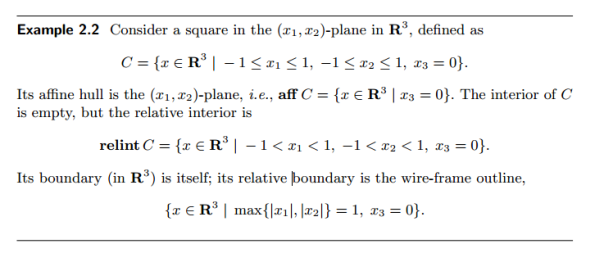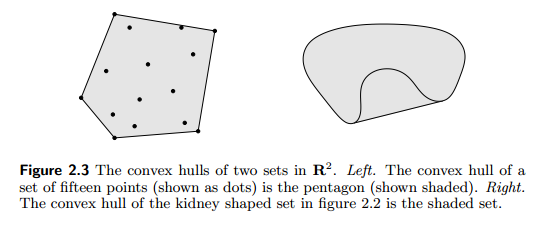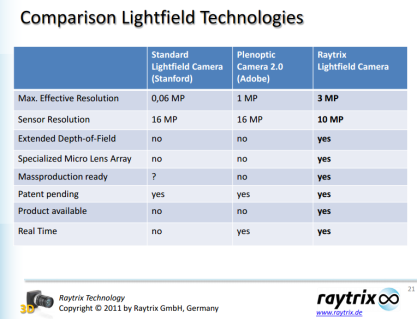Archive
The difference between adaptive optics and turbid imaging
Definition of turbid imaging: imaging through highly scattering medium, such as egg shell.
First, the medium considered in adaptive optics, such as atmosphere, has much more weakly scattering than the turbid medium in turbid imaging.
Second, the adaptive optics utilizes Zenike polynomial to approximate the distorted wavefront, which has far less degree of freedom and will result in a smooth approximation (no sudden jump of phase between two closed position). However, in turbid imaging, there can be discontinuous phase distribution in order to form constructive interference, as a result, the degree of freedom is very large (~ more than millions).
Convex optimization study notes 2: convex set
2.1.2 Affine Sets:
- A set C ⊆ Rn is affine if the line through(直线) any two distinct points in C lies in C, i.e., if for any x1, x2 ∈ C and θ ∈ R, we have θx1+(1 − θ)x2 ∈ C
- affine combination: a1x1+a2x2+a3x3+… where x1,x2,x3…belongs to affine set C, and a1+a2+…an=1; the affine combination belongs to C too.
- dimension of an affine set C : is defined as the dimension of the subspace V=C-x0,x0 is any elements belongs to C. a affine set can be expressed by C = V + x0 = {v + x0 | v ∈ V }
- subspace: a space closed at sums and scalar multiplication
- example: solution of Ax=b is a affine set, and the subspace V associated this affine set is the nullspace of A, i.e., the solution of Ax=0.
- any affine set can be expressed as a solution set of a system of linear equations.
- affine hull: the set of all affine combinations of points in some set C(C is not necessary to be affine set) is called affine null, denoted as aff C.
- The affine hull is the smallest affine set that contains C
- example of affine hull:

2.1.3 Affine dimension and relative interior
- affine dimension of a set C (not dimension of a affine set C): dimension of its affine hull.
- If the affine dimension of a set C ⊆ Rn is less than n, then the set lies in the affine set aff C != Rn
- relative interior of the set C, denoted relint C: relint C = {x ∈ C | B(x, r) ∩ aff C ⊆ C for some r > 0}, where B(x, r) = {y: norm(y-x) ≤ r} the ball of radius r and center x in the norm.
- relative boundary of a set C as cl C \ relint C, where cl C is the closure of C.
- example:

2.1.4 Convex set
- convex set: a set C is convex if the line segment (线段) between any two points in C lies in C, i.e., if for any x1, x2 ∈ C and any θ with 0 ≤ θ ≤ 1, we have θx1 (1 − θ)x2 ∈ C.
- Roughly speaking, a set is convex if every point in the set can be seen by every other point, along an unobstructed straight path between them, where unobstructed means lying in the set.
- example of convex/nonconvex set:
 convex combination: we call a point of the form θ1×1 + · · · + θkxk, where θ1 + · · · + θk= 1 and θi ≥ 0, i = 1, . . . , k, a convex combination of the points x1, . . ., xk; A convex combination of points can be thought of as a mixture or weighted average of the points, with θi the fraction of xi in the mixture.
convex combination: we call a point of the form θ1×1 + · · · + θkxk, where θ1 + · · · + θk= 1 and θi ≥ 0, i = 1, . . . , k, a convex combination of the points x1, . . ., xk; A convex combination of points can be thought of as a mixture or weighted average of the points, with θi the fraction of xi in the mixture.- convex hull: conv C = {θ1×1 + · · · + θkxk| xi ∈ C, θi ≥ 0, i = 1, . . . , k, θ1 + · · · + θk= 1}. the convex hull conv C is always convex. It is the smallest convex set that contains C.
- example of convex hull:

- The idea of a convex combination can be generalized to include infinite sums, in-tegrals, and, in the most general form, probability distributions.
2.1.5 cones
- A set C is called a cone, or nonnegative homogeneous, if for every x ∈ C and θ ≥ 0 (no other requirement) we have θx ∈ C.
- example of cone

- A set C is a convex cone if it is convex and a cone, which means that for any x1, x2 ∈ C and θ1, θ2 ≥ 0, we have θ1×1 + θ2×2 ∈ C.
- conic hull of set C is the set of all conic combinations of points in C, i.e., {θ1×1 + · · · + θkxk|xi ∈ C, θi ≥ 0, i = 1, . . . , k},which is also the smallest convex cone that contains C.
- example of conic hull:

特征值与特征向量(转)
特征值特征向量
“
特征向量确实有很明确的几何意义,矩阵(既然讨论特征向量的问题,当然是方阵,这里不讨论广义特征向量的概念,就是一般的特征向量)乘以一个向量的结果仍是同维数的一个向量,因此,矩阵乘法对应了一个变换,把一个向量变成同维数的另一个向量,那么变换的效果是什么呢?这当然与方阵的构造有密切关系,比如可以取适当的二维方阵,使得这个变换的效果就是将平面上的二维向量逆时针旋转30度,这时我们可以问一个问题,有没有向量在这个变换下不改变方向呢?可以想一下,除了零向量,没有其他向量可以在平面上旋转30度而不改变方向的,所以这个变换对应的矩阵(或者说这个变换自身)没有特征向量(注意:特征向量不能是零向量),所以一个变换的特征向量是这样一种向量,它经过这种特定的变换后保持方向不变,只是进行长度上的伸缩而已(再想想特征向量的原始定义Ax=cx,你就恍然大悟了,看到了吗?cx是方阵A对向量x进行变换后的结果,但显然cx和x的方向相同),而且x是特征向量的话,ax也是特征向量(a是标量且不为零),所以所谓的特征向量不是一个向量而是一个向量族, 另外,特征值只不过反映了特征向量在变换时的伸缩倍数而已,对一个变换而言,特征向量指明的方向才是很重要的,特征值不是那么重要,虽然我们求这两个量时先求出特征值,但特征向量才是更本质的东西!
”
Which side of the lens should face the incoming wavefront?
Some promising companies in imaging techniques and sensors design (Collection)
1. http://rebellionphotonics.com/
Focus: snap-shot hyperspectral imaging technology (production ready)
Future development: light field camera and hyperspectral camera intergrated in cell phone (no production until NOV11,2012).
Video rate light field camera for industry application (production ready)
Light field camera for consumer application (production ready)
4. http://www.pelicanimaging.com
Build light field camera in cell phone (no production until NOV11,2012).
Ad: solve low-light problem, high resolution, low power, re-focus, small.
For cell phone, using multi-aperture imaging technology.
Ad:Utilizing state-of-the-art multi aperture imaging technology that combines innovative image processing, advanced sensor and optics technology, our cameras set new standards for image quality parameters such as low light performance, HDR, refocusing, color fidelity, shutter lag and more…
Light field camera
除了Ng Ren的Lytro,有一家公司号称比Lytro更早做出了更牛的产品,叫Raytrix.
http://image-sensors-world.blogspot.sg/2012/11/raytrix-presents-its-technology.html。
这是他们自己的对比描述。
卷积的通俗理解
光学成像里面经常会用到卷积,对卷积的概念总是有时候清楚有时候模糊。以前看过一篇《大牛很通俗的通俗的介绍信号与系统》的转帖,原帖已经找不到了。转帖是科学网看到的:http://bbs.sciencenet.cn/thread-554282-1-1.html。今天又拿出来读了一遍,感觉又理解得清楚了一些,可是我可以预料到过几天我又会忘了,所以还是用自己的话再加工加工,争取理解正确。
时域信号f(t)与g(t)的卷积在文中有三个非常形象的例子:
例子1:无穷时间连续信号的卷积;
经理让新来的技术员(小王)测试一个器件,他给了技术员1000多个输入函数,让技术员告诉他这些函数的输出是什么。
小王犯憷了,1000多个函数难道一个个测啊,那什么时候能测完啊?
上帝给了小王一个方法:输入一个单位脉冲信号(能力1J)到器件里,得到这个脉冲的输出(响应),然后把输入函数想象为无数个不同幅值脉冲按时间先后顺序排队进器件,输出就是这些脉冲的响应的叠加,但是最先输入的脉冲在时间轴的最左边,因此需要翻转后叠加。
例子2:无穷时间周期信号的傅里叶变换。
经理又给了小王一个任务,这次他告诉小王一个输入波形(不能用数学函数描述的波形),这个波形时间有限长,但是总是不停的周期性的输入,让小王告诉他输出会是什么样的。
这次第一次的方法不能用了,函数表达式不知道,没法直接算出卷积来,小王束手无策。
好心的上帝又告诉了小王一个方法:你可以把这个周期信号转换(投影)到另外一个域(一组不同的基构成的域),然后这个不平整的无穷周期信号在那个域中就不是无穷的了,然后回变得平整,这个变换叫傅里叶变换,时间域的卷积在频率域是简单的相乘,完了再将乘积变化回时间域就得到了输出信号了。
上面这两个例子形象的简介卷积的定义和它与傅里叶变换的关系(其实并没有将为什么卷积在频域是乘积)。
对于光学成像系统(linear imaging system),输入一般是空间域中的pure amplitude or phase or complex amplitude,卷积的kernel就是PSF(point spread function),输出就是输入与PSF的卷积。从频域来看的话,kernel的傅里叶变化叫OTF(optcal tranform function), 输入输出分别是频率谱.
Who are working in sparse approximation and compressed sensing?
Donoho, Candes – Stanford
Tropp – CalTech
Baraniuk, W. Yin – Rice Texas
Gilbert, Strauss – U-Michigan
Gribonval, Fuchs – INRIA France
Starck – CEA – France
Vandergheynst, Cehver– EPFL Swiss
Rao, Delgado – UC San-Diego
Do, Ma – U-Illinois
Tanner, Davies – Edinbourgh UK
Elad, Zibulevsky, Bruckstein, Eldar – Technion
Goyal – MIT
Mallat – Ecole-Polytec. Paris
Daubechies – Princeton
Coifman – Yale
Romberg – GaTech
Lustig, Wainwright – Berkeley
Sapiro – UMN
Friedlander – UBC Canada
Tarokh – Harvard
Cohen, Combettes – Paris VI
Turbid imaging 2012 Nov
Several new papers to be read:
1. Katz_2012_Nature Photonics_Looking around corners and through thin turbid layers in real time with scattered incoherent light;
2. Tang_2012_PNAS_Superpenetration optical microscopy by iterative multiphoton adaptive compensation technique
